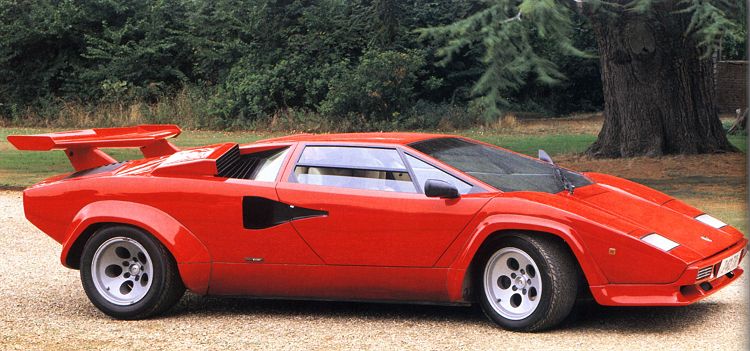Description
The Lamborghini Countach S was the model that transformed the Countach from a radical engineering marvel into a cultural phenomenon. Introduced in 1978 and officially known as the Countach LP 400 S, it took the clean, futuristic lines of the original LP 400 and added the dramatic aggression, stance, and presence that would come to define the Lamborghini image for generations. The Countach S was the poster car of its time—loud, angular, flamboyant, and impossibly fast—symbolizing the spirit of excess and innovation that made the supercar era of the late 1970s and early 1980s so unforgettable.
The S version emerged as part of Lamborghini’s continuous evolution of the Countach platform. After several years of production, the company sought to improve the LP 400’s high-speed stability and cornering capability while giving it a more visually assertive appearance. The task fell to Lamborghini’s engineering team under the guidance of Giulio Alfieri and test driver Bob Wallace, who refined the chassis, suspension, and aerodynamics. The result was a car that maintained the raw excitement of the original but with greater control, grip, and a new, unmistakably aggressive attitude.
At its heart, the Countach S used the same 3,929 cc quad-cam V12 engine as the LP 400. Mounted longitudinally behind the seats, it produced 353 horsepower at 7,500 rpm and 361 Nm of torque. Power was delivered to the rear wheels through a five-speed manual gearbox and a limited-slip differential. Although the engine’s peak output was slightly lower than the LP 400’s, the S compensated with improved traction and handling dynamics, making it faster and more stable in real-world conditions. It could accelerate from 0 to 100 km/h (62 mph) in about 5.9 seconds and reach a top speed near 295 km/h (183 mph)—figures that kept it among the world’s fastest cars.
The most defining aspect of the Countach S was its appearance. To house the new ultra-wide Pirelli P7 tyres—the largest ever fitted to a production car at the time—Lamborghini added dramatic flared wheel arches that completely changed the car’s proportions. The stance became lower, wider, and more muscular, emphasizing the wedge shape that Marcello Gandini had created for the original design. The wheels themselves were distinctive Campagnolo cast magnesium units with a “telephone dial” pattern, 8.5 inches wide at the front and an astonishing 12 inches at the rear. Many cars were fitted with the now-legendary rear wing, a towering structure that became one of the most recognizable visual signatures in automotive history, even though it offered little aerodynamic advantage.
Other exterior updates included a deeper front air dam, revised rear lights, and small detail refinements to improve cooling and airflow. The car’s body was still made of aluminium panels over a tubular spaceframe chassis, keeping weight to just under 1,500 kilograms. The S looked raw and powerful, a natural evolution of the LP 400’s purity into something that demanded attention even when standing still. It was a car that seemed alive, all edges and tension, a perfect reflection of Lamborghini’s daring philosophy.
Inside, the Countach S maintained the intimate, driver-focused cockpit that had become part of the car’s legend. The seats were low and heavily bolstered, the steering wheel small and set close to the driver’s chest, and the pedals offset due to the tight footwell. The dashboard was updated with clearer instruments and minor ergonomic improvements, but it remained a minimalist environment built for the business of driving fast. The visibility was still limited, forcing the driver to rely on instinct and experience—a challenge that added to the drama of piloting a Countach.
On the road, the Countach S was unlike anything else. The V12 engine’s deep metallic growl filled the cabin, rising into a scream as the revs climbed. The gearbox was heavy but precise, and the steering—unassisted and direct—offered extraordinary feedback once moving. The suspension revisions made the car sharper and more composed in corners, while the massive tyres provided immense grip. It was a physical car to drive, demanding strength and concentration, but for those who mastered it, the rewards were unforgettable. The Countach S felt alive—raw, mechanical, and utterly engaging, an unfiltered connection between driver and machine.
Production of the Countach S ran from 1978 to 1982, with approximately 237 examples built. Early models, known as Series I cars, retained some of the LP 400’s finer detailing, such as the “Periscopio” roof channel, while later Series II and Series III versions incorporated more aerodynamic and interior refinements. Each car was hand-built at the Sant’Agata Bolognese factory, and as with all Lamborghinis of the era, no two were exactly alike.
The Lamborghini Countach S was more than just an update—it was the car that turned the Countach into a symbol of its age. It defined what a supercar looked like, influencing an entire generation of designers and enthusiasts. Its angular form, scissor doors, and sheer audacity became the visual shorthand for speed and power.
Today, the Countach S is revered as one of the most desirable and pure expressions of the Lamborghini ethos. It bridges the elegance of the early LP 400 with the extreme theatre of the later LP 500 S and LP 5000 Quattrovalvole. It remains one of the most iconic shapes ever to roll out of Sant’Agata—a car that captured the imagination of an era and continues to stand as a masterpiece of design, engineering, and unrestrained passion.

